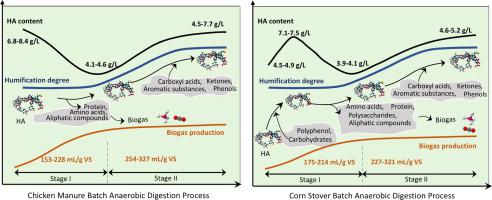Chemical Engineering Journal ( IF 13.3 ) Pub Date : 2020-10-14 , DOI: 10.1016/j.cej.2020.127322 Xiqing Wang , Atif Muhmood , Tao Lyu , Renjie Dong , Hongtao Liu , Shubiao Wu

|
Humic acid (HA), a byproduct formed during the biological conversion of organic matter into biogas in the anaerobic digestion (AD) process, contains complex structures and redox functions. However, the evolution mechanism of HA and its interaction with CH4 production during the AD process have not been fully explored, particularly with respect to various substrates and temperature conditions. In this study, we investigated the evolutionary dynamics of the structure and function of genuine HA that naturally formed in the AD processes of chicken manure and corn stover under mesophilic (37 °C) and thermophilic (55 °C) conditions. The results demonstrated that the HA evolution mechanisms in AD of chicken manure and corn stover have different pathways. The AD of core stover showed higher degree of aromaticity (41.2-66.7% and 45.3-68.4% for mesophilic and thermophilic respectively) and humification index (1.5-4.2 and 2.8-4.5 for mesophilic and thermophilic respectively) than those (28.3-45.3% and 30.2-54.5% of aromaticity and 0.6-1.2 and 1.3-3.7 of humification index) in AD of chicken manure. The results from HSQC NMR spectroscopy and 2D-COS-FTIR spectroscopy demonstrated an accelerating effect of the higher temperature on the evolution of HA through humification. Moreover, the concurrent decomposition and re-polymerization of HA during both AD processes, resulting in positive and negative effects on CH4 production in the fast and slow CH4 production stages, respectively. The dynamic interaction was due to variations in the electron transferring ability and structure of the formed HA. The results could not only advance our understanding of the mechanisms of HA evolution and its interaction with the performance of AD process, but also support further research toward improving AD performance by regulating HA formation and transformation.
中文翻译:

厌氧消化过程中腐殖酸真正释放的机理及其与甲烷生成的动态相互作用
腐殖酸(HA)是在厌氧消化(AD)过程中有机物生物转化为沼气过程中形成的副产物,具有复杂的结构和氧化还原功能。然而,HA的进化机制及其与CH 4的相互作用尚未充分探索AD工艺中的生产,尤其是在各种基材和温度条件方面。在这项研究中,我们研究了在中温(37°C)和嗜热(55°C)条件下,鸡粪和玉米秸秆AD过程中自然形成的真正HA的结构和功能的进化动力学。结果表明,鸡粪和玉米秸秆的AD中HA的进化机制不同。核心秸秆的AD显示出较高的芳香度(中温和嗜热分别为41.2-66.7%和45.3-68.4%)和增湿指数(中温和嗜热分别为1.5-4.2和2.8-4.5)(28.3-45.3%鸡粪AD中的芳香度为30.2-54.5%,腐殖化指数为0.6-1.2和1.3-3.7)。HSQC NMR光谱和2D-COS-FTIR光谱的结果表明,较高的温度通过腐殖化促进了HA的进化。此外,HA在两个AD过程中同时分解和重新聚合,从而对CH产生正面和负面影响4生产在快速和慢速CH 4分别生产阶段。动态相互作用是由于所形成的HA的电子传递能力和结构的变化。这些结果不仅可以增进我们对HA进化机制及其与AD过程性能的相互作用的理解,而且还可以通过调节HA的形成和转化来支持提高AD性能的进一步研究。











































 京公网安备 11010802027423号
京公网安备 11010802027423号